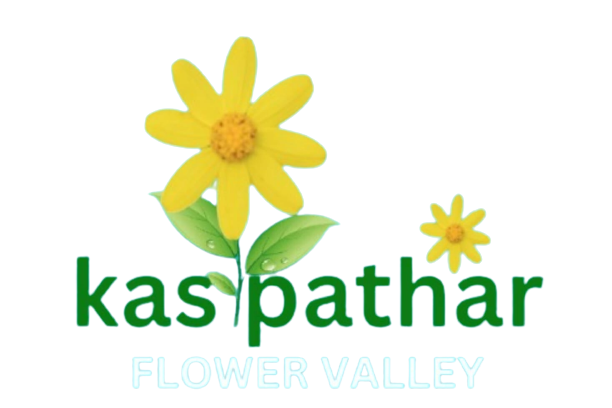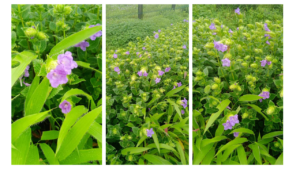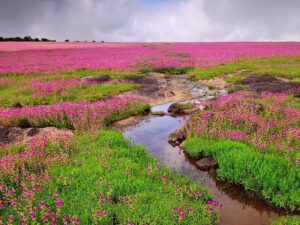Introduction:
The Kaas Plateau, nestled in the picturesque Western Ghats of Maharashtra, India, is a true gem of natural beauty and ecological significance. This unique Kaas Plateau Ecosystem has gained recognition as a biodiversity hotspot and has been designated as a UNESCO World Natural Heritage Site. In this section, we will delve into the captivating features of the Kaas Plateau and explore why it holds such importance in the realm of conservation.
Situated at an altitude of approximately 1200 meters above sea level, the Kaas Plateau spans over 10 square kilometres and is renowned for its vibrant floral diversity. It is home to more than 850 species of flowering plants, including several endemic and endangered species. The plateau transforms into a carpet of colourful blooms during monsoon season (August to October), creating a mesmerizing spectacle that attracts nature enthusiasts from far and wide.
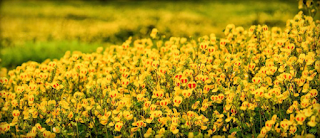
The Western Ghats region itself is recognized as one of the world’s eight hottest biodiversity hotspots due to its rich variety of flora and fauna. The Kaas Plateau stands out in this remarkable landscape for its exceptional floral wealth.
Recognizing its ecological significance, the Kaas Plateau was declared a UNESCO World Natural Heritage Site in 2012. This prestigious designation highlights its exceptional universal value in terms of biodiversity conservation and sustainable development.
In this section, we will explore how efforts are being made by authorities and local communities to preserve this fragile ecosystem while promoting responsible tourism.
Join us on this journey as we unravel the beauty and importance of the Kas Pathar ecosystem – an enchanting paradise that showcases nature’s splendour at its finest while reminding us about our responsibility towards environmental preservation.
Threats to the Kaas Plateau Ecosystem
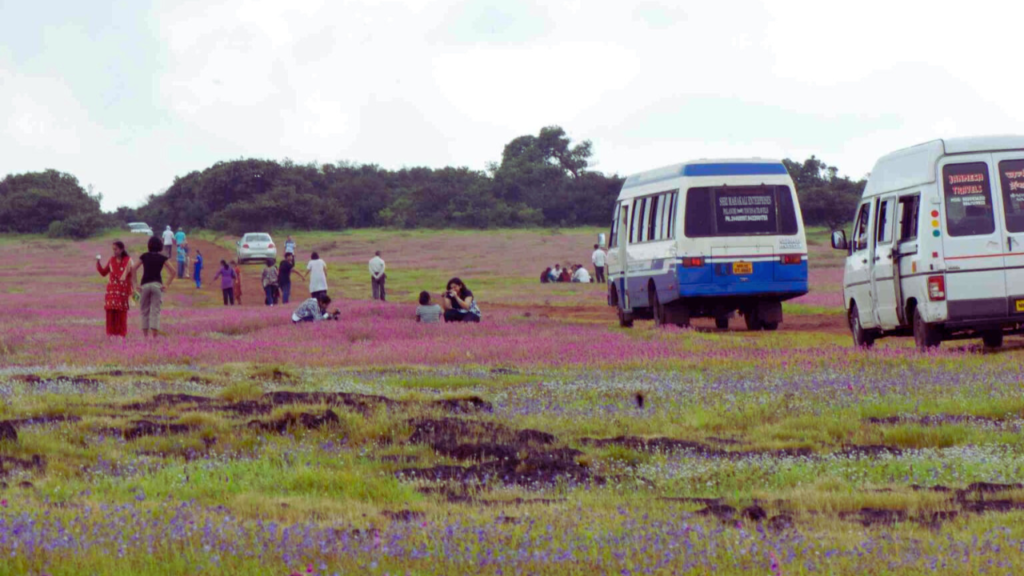
The Kaas Plateau ecosystem faces a range of threats that have impacted its delicate balance. Historically, local pressures such as grazing and burning have stressed the plateau. Domestic cattle, while coexisting with wild mammals, also compete for resources. The presence of a road passing through the plateau has led to unfortunate incidents of road kills, particularly snakes. Moreover, the inclusion of manure has played a role in the process of eutrophication.
Heavy trampling by both cattle and people has resulted in the creation of numerous paths on the plateau. However, due to the lack of baseline data, it is challenging to assess the precise impact these activities have had on the diversity of the plateau.
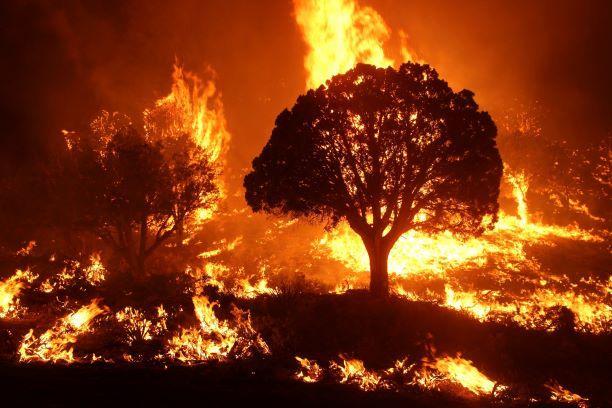
In recent years, tourism has emerged as a significant threat to the plateau and its surrounding areas. The sudden growth in popularity and visitor numbers since 2012 has raised concerns about ecological impacts. These impacts include high levels of vegetation trampling, damage to microhabitats, and solid waste management issues.

Additionally, there are less visible effects such as changes in land-use patterns in surrounding areas and socio-economic and cultural shifts in nearby villages.
It is crucial to understand these threats comprehensively to develop effective conservation strategies for preserving this unique ecosystem.
Habitat Destruction and Fragmentation
Habitat destruction and fragmentation are two critical environmental issues that significantly impact biodiversity and Kaas Plateau ecosystems. Deforestation, Forest fire, and urbanization are the main drivers of these processes, leading to habitat loss and fragmentation.
Deforestation involves the clearing of forests for various purposes such as infrastructure development. The loss of forests not only reduces biodiversity but also contributes to climate change by releasing large amounts of carbon dioxide into the atmosphere.
Habitat loss and fragmentation have severe consequences on wildlife populations. Species that once had large continuous habitats are now forced to stay in smaller forest areas where they face challenges such as limited resources, increased competition, and reduced genetic diversity.
Conservation efforts play a crucial role in mitigating habitat destruction and fragmentation. Measures such as protected areas establishment, reforestation projects, and sustainable land-use practices that consider wildlife corridors can help preserve existing habitats.
The impact on flora and fauna due to the loss of endemic plants poses a threat to local ecosystems. Endemic plants are those that are found exclusively in specific regions or habitats. When these plants disappear, it can lead to a decline in overall biodiversity and disrupt ecological processes such as nutrient cycling and soil stabilization.
Another concerning trend is the decline in pollinators and other fauna. Pollinators play a crucial role in plant reproduction by transferring pollen between flowers, enabling them to produce fruits and seeds. However, factors such as habitat destruction, climate change, and invasive species have led to a decline in pollinators all over. This affects plant reproduction.
We need to recognize the importance of preserving our flora and fauna for current and future generations. Conservation efforts aimed at protecting endangered species, restoring habitats, promoting sustainable land use practices, reducing pollution levels, and raising awareness about the value of biodiversity can help mitigate these impacts on flora and fauna.
To solve this important issue, the Maharashtra government has tried to remove the protection fence on the Kaas plateau since 2022.
Urbanization and Infrastructure Development
Urbanization and infrastructure development have become defining features of modern society. As cities continue to expand, construction projects and road development play a crucial role in shaping the urban landscape. However, this rapid urban expansion often comes at a cost to the environment, leading to habitat destruction and significant impacts on flora and fauna. Kaas Plateau, a UNESCO World Heritage Site, may be under threat Due to Illegal Construction, construction projects, and roads.
One of the most concerning consequences of urbanization is the displacement of native plants and animals. As natural habitats are cleared for construction purposes. This can lead to population declines and even extinction for endangered species that cannot adapt to these changes.
Furthermore, the destruction of natural habitats disrupts ecosystems and ecological balance. Native plants that provide food and shelter for wildlife may be replaced by non-native species or completely eradicated. This loss of biodiversity not only affects wildlife populations but also has far-reaching implications for ecosystem services such as pollination, and nutrient cycling,
It is essential for urban planning strategies to incorporate measures that prioritize conservation efforts alongside infrastructure development. This can include creating green spaces within cities, implementing wildlife corridors to connect fragmented habitats, and promoting sustainable construction practices that minimize habitat destruction.
By recognizing the importance of preserving biodiversity in urban areas, we can ensure a more harmonious coexistence between human activities and the natural world. Balancing the needs of urban expansion with environmental conservation is crucial for creating sustainable cities that support both human well-being and thriving Kaas Plateau ecosystems.
Tourism Pressure Affects Kaas Plateau Ecosystem:
Unregulated Visitation & Lack of Awareness
The Kaas Plateau, known for its breathtaking beauty and unique Kaas Plateau ecosystem, is facing significant challenges due to unregulated visitation and a lack of awareness among tourists about the importance of ecosystem conservation. During peak seasons, the plateau experiences a high influx of tourists without proper management or education about the fragile habitats that exist there.
This unregulated visitation poses a threat to the delicate balance of the ecosystem. The increased footfall can lead to trampling of vegetation, soil erosion, and disturbance to wildlife habitats. Additionally, littering and improper waste disposal by tourists further exacerbates the damage caused to this pristine environment.
One of the key issues contributing to this problem is a lack of awareness among visitors about the importance of preserving this unique ecosystem. Many tourists may not be fully informed about the fragility of these habitats or how their actions can impact them in the long term.
To address these challenges, it is crucial to implement effective management strategies that regulate visitor numbers during peak seasons and ensure proper education on ecosystem conservation. This could include measures such as implementing visitor quotas, providing guided tours with trained naturalists who can educate visitors about the importance of responsible tourism practices, and promoting sustainable tourism initiatives.
By raising awareness among tourists about the fragility of Kaas Plateau’s ecosystems and encouraging responsible behaviour, we can work towards preserving this natural treasure for future generations to enjoy while minimizing any negative impacts caused by tourism pressure.
Readers are kindly requested to visit the official website of the Kas Plateau Forest Management Committee and read the official instructions regarding the conservation of Kas Plateau.
Conclusion:
The Urgent Need for Conservation Efforts to Protect the Kaas Plateau Ecosystem.
Website link: Exploring the Beauty of Kas Pathar: A Guide to Booking Your Trip in 2023
What are the threats to the Kaas Plateau?
Kaas Plateau, a UNESCO World Heritage Site, may be under threat Due to Illegal Construction, construction projects, and road.
What is the biodiversity of the Kaas Plateau?
This unique Kaas Plateau Ecosystem has gained recognition as a biodiversity hotspot and has been designated as a UNESCO World Natural Heritage Site.
What are the environmental issues in Kaas Plateau?
Habitat destruction and fragmentation are two critical environmental issues that have a significant impact on biodiversity and Kaas Plateau ecosystems.
What is the importance of the Kaas plateau?
It is home to more than 850 species of flowering plants, including several endemic and endangered species.
How was the Kaas Plateau formed?
Kaas Plateau was formed by volcanic activities and is covered by a thin soil cover as a result of which, no vegetation thrives in the region. This area comes under very high rainfall zone. Due to this, the flora and fauna of the region is unique and endemic
